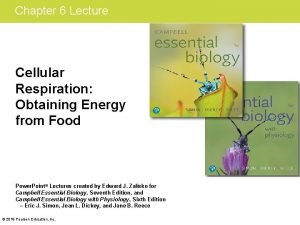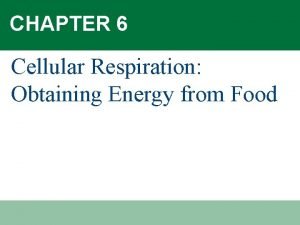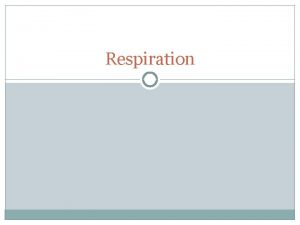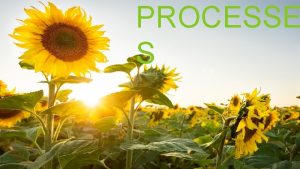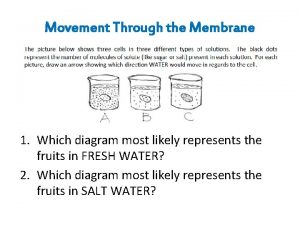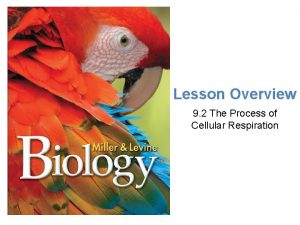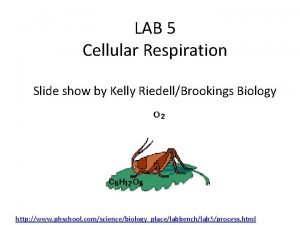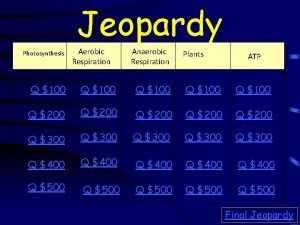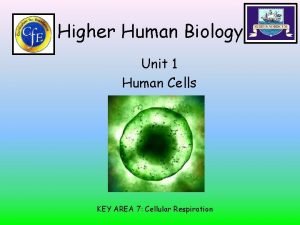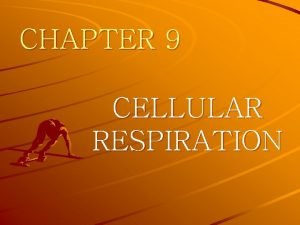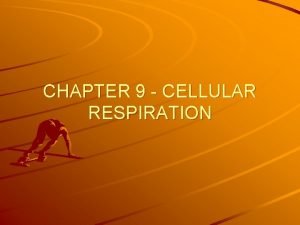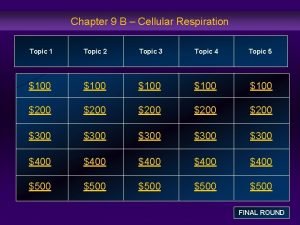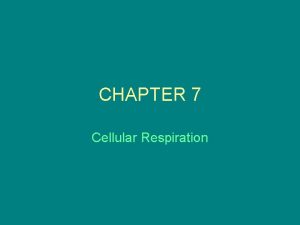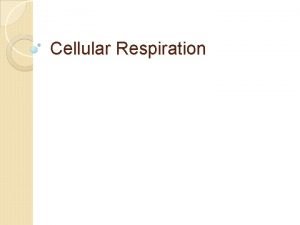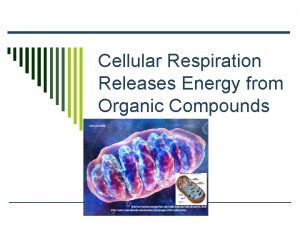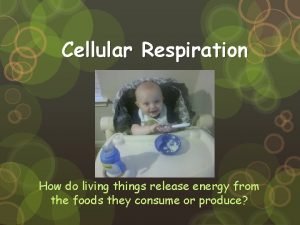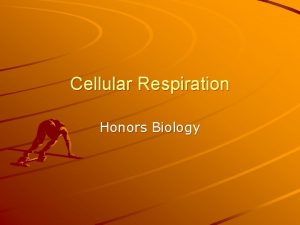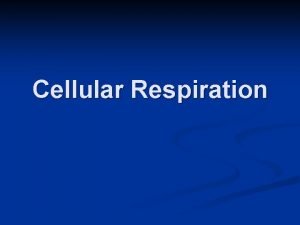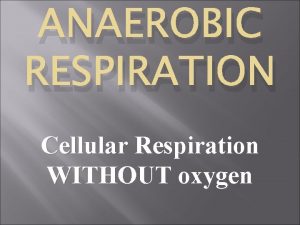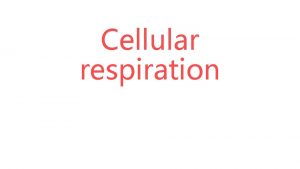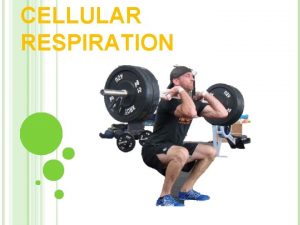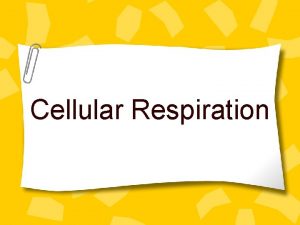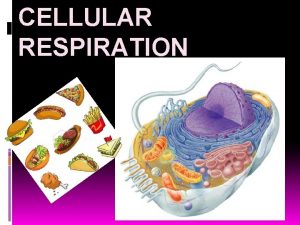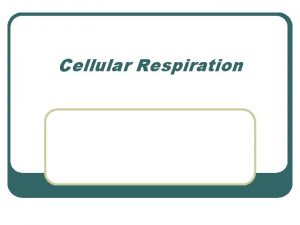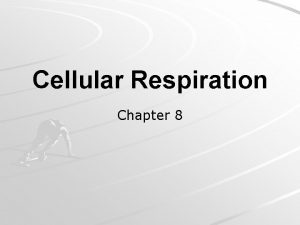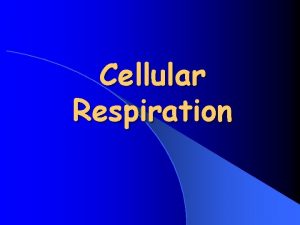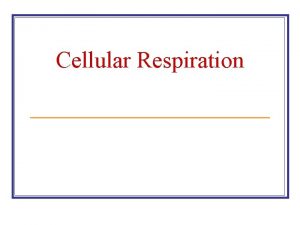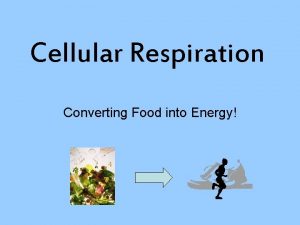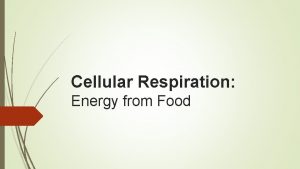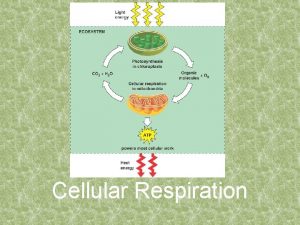9 1 Cellular respiration Intro Food provides living






























- Slides: 30

9. 1 Cellular respiration.

Intro Food provides living things with the chemical building blocks they need to grow and reproduce. Food serves as a source of raw materials from which the cells of the body can synthesize new molecules.

Chemical Energy in Food One gram of the sugar glucose (C 6 H 12 O 6), when burned in the presence of oxygen, releases 3811 calories of heat energy A calorie is the amount of energy needed to raise the temperature of 1 gram of water 1 degree Celsius.

Chemical Energy in Food The Calorie (capital “C”) that is used on food labels is a kilocalorie, or 1000 calories. Cells, of course, don't “burn” glucose.

Chemical Energy in Food This process begins with a pathway called glycolysis (gly-KAHL-ih-sis). Glycolysis releases only a small amount of energy.

Chemical Energy in Food If oxygen is present, aerobic, glycolysis leads to two pathways that release a great deal of energy. – Kreb’s and ETC If oxygen is not present, anaerobic, glycolysis is followed by a different pathway. – Fermentation

Overview of Cellular Respiration Glycolysis, the Krebs cycle, and the electron transport chain make up a process called cellular respiration. Cellular respiration is the process that releases energy by breaking down glucose and other food molecules in the presence of oxygen.

Overview of Cellular Respiration

Overview of Cellular Respiration Equation for cellular respiration is:

Overview of Cellular Respiration If cellular respiration took place in just one step, all of the energy from glucose would be released at once, and most of it would be lost in the form of light and heat.

Glycolysis is the process in which one molecule of glucose is broken in half, producing two molecules of pyruvic acid, a 3 carbon compound.

Glycolysis

Glycolysis ATP Production – the cell needs to put in a little energy to get things going. – At the pathway's beginning, 2 molecules of ATP are used up.

Glycolysis Those 2 ATP molecules are like an investment that pays back interest. – In order to earn interest from a bank, first you have to put money into an account. Although the cell puts 2 ATP molecules IN its “account” to get glycolysis going, when glycolysis is complete, 4 ATP molecules have been produced, come OUT. This gives the cell a net gain of 2 ATP molecules.

Glycolysis NADH Production – One of the reactions of glycolysis removes 4 high-energy electrons and passes them to an electron carrier called NAD+ – NAD+ + H+ + 2 e- = NADH

Glycolysis Besides speed, another advantage is that glycolysis itself does not require oxygen. – This means that glycolysis can supply chemical energy to cells when oxygen is not available.

Glycolysis Without NAD+, the cell cannot keep glycolysis going, and ATP production stops. Thus the process is followed by fermentation which recycles the electron carriers to continue to supply glycolysis so it can make energy.

Fermentation When oxygen is not present, glycolysis is followed by a different pathway. Fermentation releases energy from food molecules by producing ATP in the absence of oxygen.

Fermentation During fermentation, cells convert NADH to NAD+ by passing high-energy electrons back to pyruvic acid. This action converts NADH back into the electron carrier NAD+, allowing glycolysis to continue producing a steady supply of ATP. Because fermentation does not require oxygen, it is said to be anaerobic. The term anaerobic means “not in air. ”

Fermentation The two main types of fermentation are – alcoholic fermentation – lactic acid fermentation.

Fermentation Yeasts and a few other microorganisms use alcoholic fermentation, – forming ethyl alcohol and carbon dioxide as wastes.

Fermentation The equation for alcoholic fermentation after glycolysis is:

Fermentation -Alcoholic

Fermentation Alcoholic fermentation causes bread dough to rise Giving off bubbles of carbon dioxide that form the air spaces you see in a slice of bread. The small amount of alcohol produced in the dough evaporates when the bread is baked.

Fermentation Bread – bubbles show result of alcoholic fermentation Wine/Beer- created by alcoholic fermentation

Fermentation Lactic Acid Fermentation In many cells, the pyruvic acid that accumulates as a result of glycolysis can be converted to lactic acid. Because this type of fermentation produces lactic acid, it is called lactic acid fermentation.

Fermentation The equation for lactic acid fermentation after glycolysis is:

Fermentation - Lactic Acid

Fermentation Lactic acid is produced in your muscles during rapid exercise when the body cannot supply enough oxygen to the tissues. The buildup of lactic acid causes a painful, burning sensation. This is why muscles may feel sore after only a few seconds of intense activity.

Fermentation Prokaryotes are used in the production of a wide variety of foods and beverages, such as cheese, yogurt, buttermilk, and sour cream. Pickles and sauerkraut are also produced using lactic acid fermentation.
 Cellular respiration obtaining energy from food
Cellular respiration obtaining energy from food Cellular respiration obtaining energy from food
Cellular respiration obtaining energy from food Cellular respiration redox
Cellular respiration redox The gray-brown haze often found over large cities is called
The gray-brown haze often found over large cities is called Cellular respiration steps
Cellular respiration steps Where is aerobic respiration located
Where is aerobic respiration located Fermentation pathway
Fermentation pathway Why is cellular respiration important
Why is cellular respiration important The process of photosynthesis and cellular respiration
The process of photosynthesis and cellular respiration What plant need for photosynthesis
What plant need for photosynthesis Amloplast
Amloplast Photosythesis equation
Photosythesis equation Photosynthesis recipe card
Photosynthesis recipe card Electron carriers in cellular respiration
Electron carriers in cellular respiration Overview of cellular respiration
Overview of cellular respiration Respiration overview
Respiration overview Cellular respiration
Cellular respiration Overview of cellular respiration
Overview of cellular respiration Lab bench cellular respiration
Lab bench cellular respiration What is the word equation for cellular respiration
What is the word equation for cellular respiration Higher human biology cellular respiration
Higher human biology cellular respiration Chemical formula for cellular respiration
Chemical formula for cellular respiration What are the reactants and products of photosynthesis?
What are the reactants and products of photosynthesis? Cellular respiration releases
Cellular respiration releases Starting materials for cellular respiration
Starting materials for cellular respiration Chapter 8 section 3: cellular respiration
Chapter 8 section 3: cellular respiration Redox reaction in cellular respiration
Redox reaction in cellular respiration Cellular respiration formula
Cellular respiration formula Role of cellular respiration
Role of cellular respiration Cellular respiration releases
Cellular respiration releases Cellular respiration redox
Cellular respiration redox
